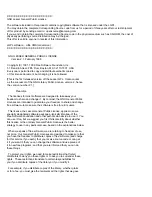
Chapter 2. Architecture and planning
49
WebSphere Portal Server instance associated with a stand-alone WCM deployment can be
managed on the same machine in isolation.
2.7.4 Database high availability
To safeguard against catastrophic failure of the proposed WebSphere Portal Server solution,
it is essential that the database tier is highly available. When using DB2, two principle
methods exist for achieving high availability.
High Availability Cluster Multiprocessing
High Availability Cluster Multiprocessing (HACMP™), can be used to implement hardware
clustering. That is, HACMP can automatically switch over from a failing server to another
server, thus minimizing unscheduled down time. As such, the HACMP software detects that
there is a problem with the initially active node and initiates the following actions on the
standby node:
Take over the applicable IP addresses.
Take over the shared disks.
Start the necessary application processes.
This is commonly known as a cold-standby configuration; only one node is actively running
workload at a time. Furthermore, it is important to recognize that HACMP does not offer data
redundancy.
Appendix B, “7x24 Maintenance” in the
HACMP for AIX 5L V5.2 Administration and
Troubleshooting Guide
, SC23-4862 has the most current and comprehensive information
about maintaining a cluster in a 24X7 environment. It can be found along with the other
documentation for HACMP at the following Web site:
http://www.ibm.com/servers/eserver/pseries/library/hacmp_docs.html
HADR
DB2 High Availability Disaster Recovery (HADR) provides a new alternative for delivering a
high availability solution by replicating data from a source database, called the Primary, to a
target database, called the Standby. HADR provides protection for both partial and complete
site failures. Combined with the new Automatic Client Reroute (ACR) capability, HADR
provides transparency to the application regardless of the failure type, from hardware,
network, or software issues to disaster scenarios like fire. HADR provides multiple levels of
protection allowing flexibility in the environment. Additionally, DB2 provides an easy to use
wizard that allows the entire configuration to be set up in a matter of minutes.
HADR functionality is available as part of the DB2 UDB Enterprise Server Edition at no extra
charge. Users of DB2 UDB Express and DB2 UDB Workgroup Server Editions can add
HADR function to their servers by purchasing the DB2 UDB High Availability Disaster
Recovery Option.
Tip:
For those organizations using Oracle as their preferred database, the DB2
terminology described in the WebSphere Portal Server Version 6.0 Information Center can
lead to confusion. In Oracle terms, a WebSphere Portal Server database domain should
be considered an Oracle schema. As such, multiple schemas can exist within the same
Oracle database. However, for the reasons outlined previously, it may on occasion prove
beneficial to architect a separate Oracle database for a particular schema, for example,
when considering the JCR Repository requirements of WCM and PDM.
Summary of Contents for BS029ML - WebSphere Portal Server
Page 2: ......
Page 14: ...xii IBM WebSphere Portal V6 Self Help Guide...
Page 22: ...8 IBM WebSphere Portal V6 Self Help Guide...
Page 68: ...54 IBM WebSphere Portal V6 Self Help Guide...
Page 98: ...84 IBM WebSphere Portal V6 Self Help Guide...
Page 150: ...136 IBM WebSphere Portal V6 Self Help Guide...
Page 240: ...226 IBM WebSphere Portal V6 Self Help Guide...
Page 241: ......
















































